- Weblogic Tutorial | A Comprehensive Guide for Beginners
- jBPM – Open Source Business Automation Toolkit | Complete Guide [STEP-IN]
- What is Siebel CRM – Tutorial | A Complete Guide for Beginners
- Liferay Beginner’s Guide Tutorial | Quickstart – MUST- READ
- What is Siebel CRM – Tutorial | A Complete Guide for Beginners
- MS Project Tutorial
- “Microsoft Dynamics 365 Tutorial “
- Appian Tutorial
- BizTalk Server Tutorial
- JBOSS Tutorial
- hybris Tutorial
- Netsuite Tutorial
- Documentum Tutorial
- Workday Tutorial
- Weblogic Tutorial | A Comprehensive Guide for Beginners
- jBPM – Open Source Business Automation Toolkit | Complete Guide [STEP-IN]
- What is Siebel CRM – Tutorial | A Complete Guide for Beginners
- Liferay Beginner’s Guide Tutorial | Quickstart – MUST- READ
- What is Siebel CRM – Tutorial | A Complete Guide for Beginners
- MS Project Tutorial
- “Microsoft Dynamics 365 Tutorial “
- Appian Tutorial
- BizTalk Server Tutorial
- JBOSS Tutorial
- hybris Tutorial
- Netsuite Tutorial
- Documentum Tutorial
- Workday Tutorial
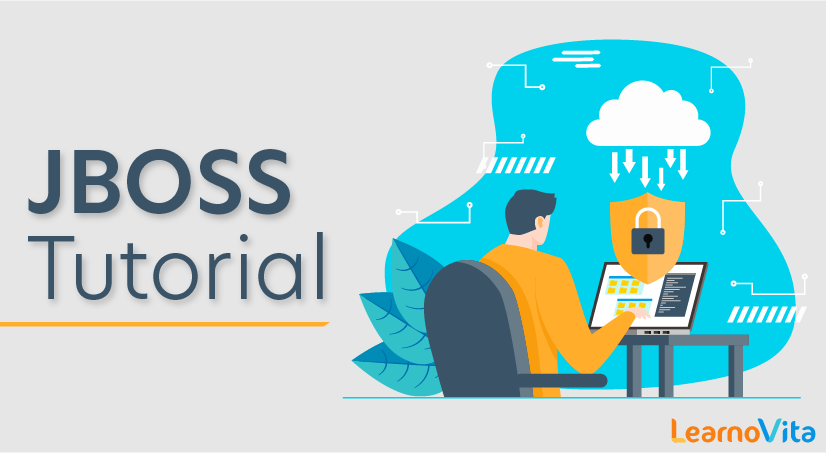
JBOSS Tutorial
Last updated on 29th Sep 2020, Blog, Enterprise Application, Tutorials
JBoss is an open-source platform that can aid the enterprises in the implementation of JAVA EE apps. It is an integrated development environment and middleware software for further development and enhancement of applications. JBoss is platform friendly and is quite easy to use. These two features have gathered much popularity for the usage of this App server. In a very short time itself, JBoss has been giving a very strong competition to IBM WebSphere as well as the SAP NetWeaver. With the development of JBoss, the organizations now have a runtime platform that can help them to build, deploy, and host some of the highest transactional apps of Java. Here we have prepared a small JBoss Tutorial for you. This JBoss tutorial will give you the essential basics related to the JBoss Architecture, JBoss Features, JBoss Advantages, and much more. Stay tuned, while we walk you through the basics in this JBoss Tutorial.
What is JBoss?
A JBoss application server is an open-source platform, that has been developed by Red Hat. The suite is majorly used for executing Java applications along with a wide combination of other programming apps. You can produce and pass on Java organizations to be scaled to fit the size of your business. Right, when you join a JBoss application server with WildFly 10 you can open a couple of cool features, for example, illuminating, high-availability gathering, and scattered putting away.
If an open-source contraption causes you worries, you don’t have to anymore—the JBoss application server is reliable with Java Enterprise Edition 7 subtleties. You can run the JBoss application server on Linux, Unix, OS X, and Windows.
With a JBoss application server, you get a high class, attempt grade stage both reliable and flexible for zero cost. Its organization arranged and point of view orchestrated structures make a fusion with various devices a snap. Furthermore, not at all like most open-source mechanical assemblies, the JBoss application server goes with each moment of the consistently capable sincerely strong system included designers, so you’re not surrendered when you experience specific difficulties.
The JBoss application server is popularly referred to as JBoss AS, and various people use it frequently with JBoss Enterprise Application Server (EAS) or WildFly.
Subscribe For Free Demo
Error: Contact form not found.
Features of JBoss
1. Undertow
First of all, JBoss EAP 7 uses Undertow as its web server. Undertow replaces JBoss Web, the webserver in prior discharges, and… it’s quick.
An extremely light web server with some cool highlights, similar to help for various HTTP conventions is what characterizes undertow the best. Having an incredibly lightweight web server choice incorporated with JBoss EAP 7 is decent, particularly since (as noted beneath) you are allowed to utilize other, heavier-obligation highlights on the off chance that you need. In any case, Undertow implies you can likewise keep things light if that is your inclination.
Moreover, Undertow in EAP 7 is intended to be adaptable and particular. Servers are made out of handlers, which you can chain together varying. That implies you can take a secluded, microservices-based way to deal with the JBoss web server, which helps JBoss EAP 7 fit naturally into your DevOps work process.
2. Clustering Modes
While working on JBoss EAP 7 backup can be bundled in two fundamental clusters. You can adopt a heap adjusting strategy by letting JBoss circulate solicitations to your servlets, or spotlight on high accessibility, which means keeping additional assets close by to give programmed failover if something goes down.
A pleasant aspect regarding JBoss EAP 7 is the adaptable methodology it takes to web server bunches. Notwithstanding the implicit web server, you can likewise utilize your preferred outside server, for example, Apache HTTPD or Microsoft IIS. To make outer servers work with JBoss, you utilize straightforward connectors, similar to the mod_jk or mod_proxy connectors from Apache, or the ISAPI and NSAPI connectors for IIS.
3. Backward-compatibility
JBoss EAP 7 likewise disentangles in reverse similarity by permitting JBoss EAP 7 space executives to oversee JBoss EAP 6 area hosts and servers. Remote EJB conjuring interoperability between JBoss EAP 7 on one side and JBoss EAP adaptations 5 and 6 on the other is likewise bolstered.
4. Suspend and Resume Functionality
The developer can suspend and continue your PC varying. Why not suspend your JBoss server, as well?
The features of Suspend and resume were presented with WildFly 9, and they’re accessible in JBoss EAP 7. Suspend closes the server down smoothly by permitting it to finish undertakings without tolerating new ones. You can continue again at whatever point you like.
JBoss Training
- Master Your Craft
- Lifetime LMS & Faculty Access
- 24/7 online expert support
- Real-world & Project Based Learning
Explore Curriculum
Support for Java EE 7 and Java SE
JBoss EAP 7 is a confirmed Java EE 7 application server and supports Java SE 8. Java EE 7 remembers four new particulars and a concentration for engineer profitability and web-scale applications. Notwithstanding determination support, JBoss EAP 7 additionally incorporates improvements intended to boost efficiency and execution. One model is clump tooling, which empowers engineers to all the more effectively screen, make, oversee, and arrange cluster jobs.
Optimized for container and cloud deployments
Worked for maintaining containers and asset cognizant virtualized or cloud conditions, for example, OpenShift by Red Hat, JBoss EAP 7 highlights a low-memory impression for higher thickness organizations, quicker startup, and streamlined system port use.
Load Balancing
JBoss AS parities the load accumulated from the approaching solicitation either by including the new equipment or introducing the product load balancer e.g-mod_jk.
Caching
JBoss AS gives a brief stockpiling territory where much of the time got to information can be put away for fast access. When the information is put away in the reserve, it very well may be utilized later on by getting to the stored duplicate instead of re-bringing or re-figuring the first information.
Failover
If one server goes down, control is passed to the next server. To keep up the meeting Heartbeat programming is arranged in JBoss AS.
Aspect-Oriented Programming (AOP) support
JBoss AS supports Aspect-arranged programming (AOP) which is a programming paradigm that expands particularity by permitting the cross-cutting concerns, separation of framing a reason for viewpoint situated programming advancement.
Enterprise Java Beans
The architecture of JBoss successfully underpins Enterprise JavaBeans (EJB), which is an overseen, server-side part design for the particular development of big business applications.
JNDI (Java Naming Directory Interface)
JBoss underpins the Java Naming and Directory Interface (JNDI), which is a piece of the Java stage, furnishing applications dependent on Java innovation with a bound together interface to different naming and catalog administrations. Ground-breaking and convenient index empowered applications can be fabricated utilizing this important feature and standard of the industry.
Enhanced administration and management
JBoss EAP 7 forms and develops the EAP6 the executives reassure and boost managerial efficiency by making it simple to keep up and update your arrangements. JBoss EAP 7 highlights a refreshed administration comfort UI with a natural route and backing for huge scope area designs. The refreshed order line interface gives a fast, brought together view into designs and subsystems while offering the capacity to oversee servers disconnected. This can be utilized with mainstream arrangement the executive’s instruments, for example, Ansible Tower by Red Hat or Puppet—making altering XML design records pointless.
JBoss Advantages
Decrease unpredictability
One JBoss Web Server membership incorporates ensured and coordinated programming with all that you have to manufacture and deal with the web applications your basic business activities rely upon. It likewise causes you to maintain a strategic distance from incorporation and form clashes.
Increment solidness
JBoss Web Server gives your IT undertaking a steady and secure web application framework with long haul unwavering quality. Each discharge profits by unsurprising updates—including deformity fixes and includes—and keeps up application similarity for as long as 5 years.
Bind together under 1 online interface
Each JBoss Web Server membership incorporates access to the endeavor IT activities entrance for programming the board, including update and ready warnings.
Get devoted security
JBoss’s devoted Product Security tracks all the security issues and characterizes them criticality plots the affected use cases, and conveys basic security refreshes as they’re distinguished.
JBoss Architecture
IMAGE
JBoss AS is gathered from a lot of autonomous, yet coordinating parts and administrations that are conveniently bundled and completely hot-deployable. It has been architected to get embedded seamlessly in applications, and the idea of its inserting is adaptable to the prerequisites of the application itself. Just the fundamental application server segments, thus, should be brought along as a major aspect of the application’s standard impression. Engineers can likewise effectively make and add their administrations to the framework, in this way guaranteeing custom administrations show similar reliable conduct as the JBoss standard arrangement of administrations.
Significant Terms of JBoss Architecture
Server
In the JBoss world, a Server speaks to the entire compartment. JBoss gives a default execution of the Server interface., and clients infrequently alter this.
Administration
A Service is a middle part that lives inside a Server and binds at least one Connectors to precisely one Engine. The Service component is once in a while altered by clients, as the default execution is basic and adequate: Service interface.
Motor
An Engine speaks to the demand handling pipeline for a particular Service. As a Service may have different Connectors, the Engine got and forms all solicitations from these connectors, giving the reaction back to the suitable connector for transmission to the customer. The Engine interface might be actualized to gracefully custom Engines, however, this is exceptional.
Note that the Engine might be utilized for JBoss server bunching employing the jvmRoute parameter. Peruse the Clustering documentation for more data.
Host
A Host is a relationship of a system name, for example, www.yourcompany.com, to the JBoss server. An Engine may contain different hosts, and the Host component additionally bolsters arrange pseudonyms, for example, yourcompany.com and abc.yourcompany.com. Clients once in a while make custom Hosts because the StandardHost usage gives noteworthy extra usefulness.
Connector
A Connector handles correspondences with the customer. There are various connectors accessible with JBoss, all of which actualize the Connector interface. These incorporate the Coyote connector which is utilized for most HTTP traffic, particularly when running JBoss as an independent server, and the JK2 connector which actualizes the AJP protocol utilized while associating JBoss to an Apache HTTPD server. Making a tweaked connector is a critical exertion.
Setting
A Context speaks to a web application. A Host may contain different settings, each with a one of a kind way. The Context interface might be actualized to make custom Contexts, however, this is once in a while the case because the StandardContext gives huge extra usefulness.
Installation Procedure of the JBoss Setup
1. Create another organizer on your PC (for instance, C:\JBoss (Windows) or ~/jboss/(UNIX)). This progression is discretionary, as you may wish to utilize the way inserted in the establishment .compress document.
2. Use your program to explore the JBoss Community page: http://www.jboss.org/jbossas/downloads/. To get to this page, you should be an enlisted client, and you have to sign in. Subtleties of how to achieve this undertaking are given on the JBoss Community site.
3. Under Version, find “JBoss AS 6.1.0. Final”, and snap-on “Flash” in the related Download section. This activity will download an establishment document named JBoss-as-conveyance 6.1.0.Final.zip to your PC.
Note: a similar document is utilized for the two Windows and Unix.
4. Extract the establishment records into the envelope that you alternatively made in sync 1.
Note: Guarantee that the choice to hold folder names is chosen.
What Is a JBoss Application Server?
If you’re as tapped in to the computer software community as I am, you might’ve noticed some chatter about JBoss. Red Hat, ASRC Federal Holding Company, and other multimillion-dollar software companies use JBoss application server as a framework for their products.
So, what is the JBoss enterprise application platform? How do you use a JBoss application server? How do you set up a JBoss server configuration? This JBoss server tutorial will answer all these questions. At the end of the tutorial, I’ll tell you how to get the most out of your JBoss application server with a powerful JBoss application monitoring tool.JBoss application server is an open-source platform, developed by Red Hat, used for implementing Java applications and a wide variety of other software applications. You can build and deploy Java services to be scaled to fit the size of your business. When you integrate a JBoss application server with WildFly 10 you can unlock several cool features, like messaging, high-availability clustering, and distributed caching.
If open-source tools make you a little nervous, fear not—JBoss application server is compliant with Java Enterprise Edition 7 specifications. You can run JBoss application server on Linux, Unix, OS X, and Windows.
With a JBoss application server, you get a high class, enterprise-grade platform both reliable and scalable for zero cost. Its service-oriented and aspect-oriented structures make integration with other tools a snap. Also, unlike most open-source tools, JBoss application server comes with a 24/7 professional support system made up of developers, so you’re not left in the lurch when you experience technical difficulties.
JBoss application server is often abbreviated as JBoss AS, and many people use it interchangeably with JBoss Enterprise Application Server (EAS) or WildFly. For the purposes of this tutorial, we’re sticking with “JBoss application server” or “JBoss server” throughout.
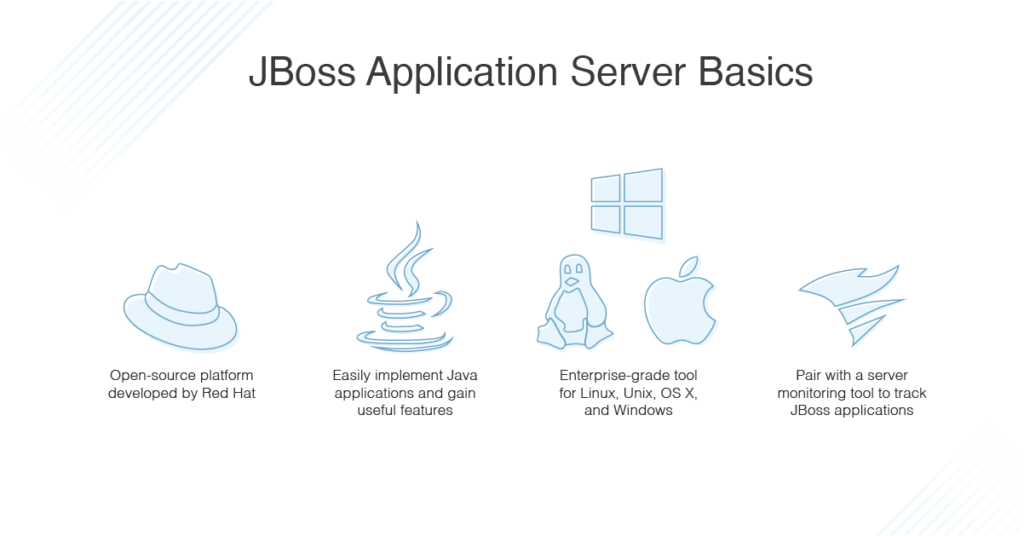
For this JBoss server tutorial I’m going to touch on the basics of configuration and deployment. Let’s break it down:
JBoss Server Configuration
Installing JBoss application server is easy—you can do it via the installer or ZIP file. Just make sure your system is Java 8 compliant and you have full administrative privileges.
JBoss AS uses a modular structure giving you two different options for setup—standalone server and managed domain. Standalone server is best for running JBoss AS as a single-server instance, while managed domain is best if you have multiple servers and want to be able to manage them from a single access point.
A quick word about this kind of structure: with modules you have to set explicit dependencies to be defined on all other modules within the system. To add external modules, change the JBOSS_MODULEPATH environment variable and use the following command:
- export JBOSS_MODULEPATH=”$JBOSS_HOME/modules:/opt/jboss-eap/custom-modules”
For Linux/Unix/OS X, keep this command the same. For Windows, change the colon path separator to a semicolon.
JBoss AS uses standalone scripts to set defaults, but you can get around this by inputting the following command in the configuration file, which is located in the configuration directory: –c=name-of-config.xml.
Here’s your selection of startup scripts you can use to set up your own default settings:
- Linux/Unix/OS X: $JBOSS_HOME/bin/standalone.sh
- Windows: %JBOSS_HOME%\bin\standalone.bat
Domain startup scripts are subtly different, but the process of configuring them is the same:
- Linux/Unix/OS X: $JBOSS_HOME/bin/domain.sh
- Windows: %JBOSS_HOME%\bin\domain.bat
The next thing you’re going to want to do is set up administrative roles and users. Create management and application users by entering one of the following scripts:
- Linux/Unix/OS X: $JBOSS_HOME/bin/add-user.sh
- Windows:%JBOSS_HOME%\bin\add-user.bat
Management and application users will be stored, respectively, in these two “.properties” files: “mgmt-users.properties” and “application-users.properties.” After you’ve done that, you’ll be prompted through to configure individual users.
To access these files as a whole, input $JBOSS_HOME/standalone/configuration directory for a standalone server and $JBOSS_HOME/domain/configuration directory for a domain server. The operating system doesn’t matter in this instance.
You can also play around with standalone servers and managed domains by using the web console JBoss AS provides. Create a management user with one of the add-user scripts above, then open a web browser and navigate to http://localhost:9990.
How to Deploy JBoss Application Server
There are a bunch of ways to deploy JBoss application server in Linux, Unix, OS X, and Windows. However, only the standalone server has a separate deployment directory. For more information, check out the “Read Me” txt.file located in the $JBOSS_HOME/standalone/deployments directory.
The most common methods for application deployment are via web console, command line interface, and Maven plugin.
- Web Console: Open the “Deployments” tab and select “Add” in the left column. If you’re using a domain server, click “Add” in the “Content Repository” section of the “Deployments” tab. This will open up a wizard you’ll use to deploy the application.
- CommandLineInterface:Enterdeploy—server-groups=main-server-group /path/to/app/application.war for domain.
- Maven Plugin: Download this plugin and you’ll be able to deploy applications for both kinds of servers.
Now that you know your way around JBoss application server, it’s time to take JBoss to the next level.
Best JBoss Application Server Monitoring Tools
Once you’ve started using JBoss application server to build Java applications, you’re going to need an enterprise-grade tool to make sure your applications are running smoothly. SolarWinds® Server & Application Monitor (SAM) has a wealth of features to make JBoss monitoring and troubleshooting easy.
With SAM you can:
- Keep track of health statuses for all applications running on your JBoss platform
- Look into a ton of memory-related metrics, like heap, non-heap, leaks, pool, and more
- Make sure you’re using your hardware efficiently
- Monitor applications in your Java environment for almost every major platform—JBoss, Oracle, MySQL, Tomcat, Linux, VMware, etc.
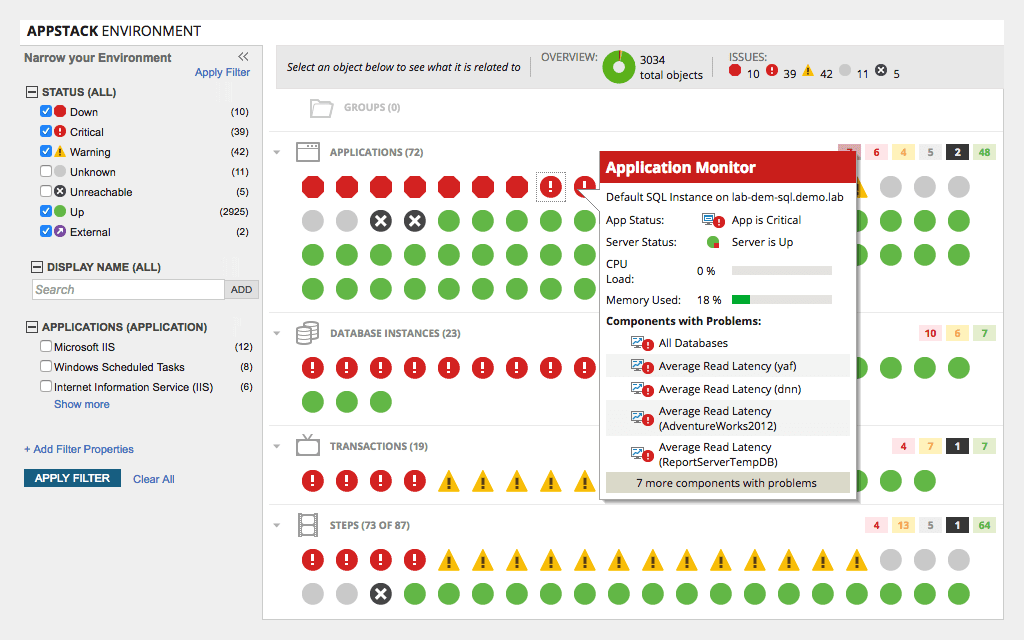
If you plan on working with a JBoss application server in the future, I highly recommend giving SolarWinds Server & Application Monitor a try. Check out the 30-day free trial, which gives you access to the tool’s full functionality.
Installing JBoss Application Server
This section details the steps you take to install JBoss Application Server (AS).
Download and install JBoss
- 1. In a browser, open the 3.3. DOWNLOAD AND INSTALL JBOSS EAP USING THE ZIP page located on the Red Hat Web site.
- 2. Follow the instructions provided to download and install the Red Hat JBoss Enterprise Application Platform. For a list of supported versions, see Additional Software Requirements.
Note: This download might require a Red Hat subscription.
Install Jboss Server
Step 1) Jboss server can be downloaded from the following link:
After downloading the latest version of the server from the link, we will get a zip file which needs to be unzipped.
After unzipping it, it takes to the below folder:
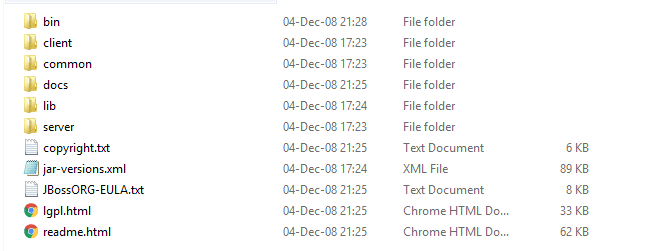
We can start and stop the server using start and stop exe from the bin folder.
Step 2)We can include the server into eclipse IDE using following way:
- Create a new server by adding name to it as localhost
- Select the version of server from the list of servers
- Server name will be added here as JBOSS v5 at localhost(the one which is selected in above two steps)
- Click on the finish button to complete the steps.
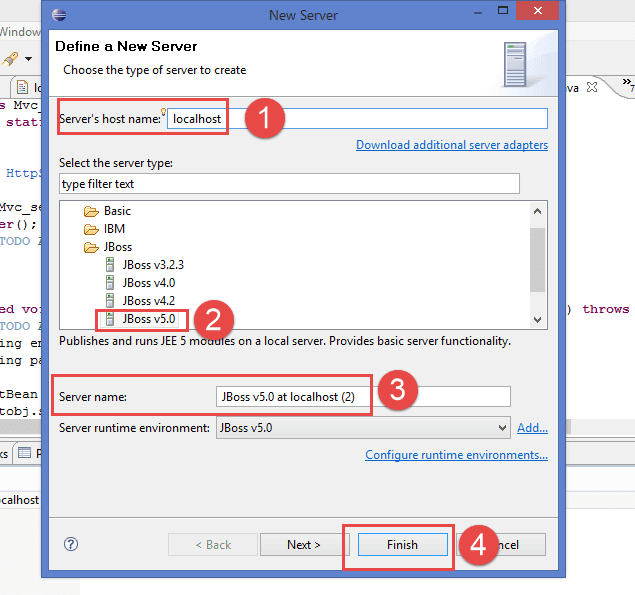
Need to define which version of the server we are using, and we can specify the path from which we have unzipped above.
Once we click on finish button, then the server would be added to eclipse IDE.

Installation of Jboss has been done, and server can be accessed from here.
Installation Testing
- Once Java and Jboss server have been installed on the machine, we can start using them in the eclipse IDE.
- In eclipse IDE, we check that there are no errors and java path has been set as an environment variable.
- If above steps are executed successfully, then the server will start successfully.

The server has been started successfully.
Install JBOSS AS tools in Eclipse
To enable Eclipse to manage JBoss Application Server, you need to install the JBoss AS tools in Eclipse:
- 1. Start Eclipse.
- 2. Click Window > Preferences > Server > Runtime Environments.
- 3. Click Add.
This opens the New Server Runtime Environment dialog box. - 4. Expand Red Hat JBoss Middleware.
- 5. Click JBoss AS, WildFly, & EAP Server Tools, and then click Next.
- 6. Accept the license agreement, and then click Finish.
- 7. If you are presented with a security warning about unsigned content, ignore it by clicking OK.
- 8. Click Yes to restart Eclipse
Conclusion
In this JBoss tutorial we have covered: JBoss architecture, JBoss features, JBoss application deployment, JBoss configuration, JBoss benefits, and JBoss installation process. These are some of the most important things that you must know concerning the working of JBoss.
I hope this JBoss tutorial has given you a good insight into various concepts related to the topic. You can take this reading as one of the primary steps towards garnering an in-depth knowledge about JBoss.
Feel free to get back to us in case of any query or doubt. We will resolve it.
